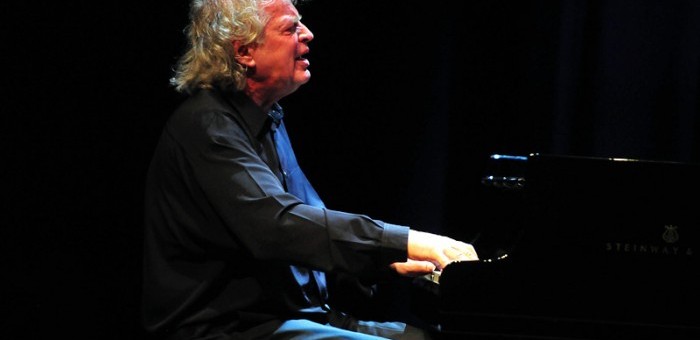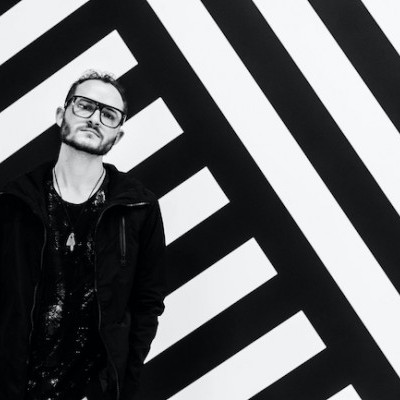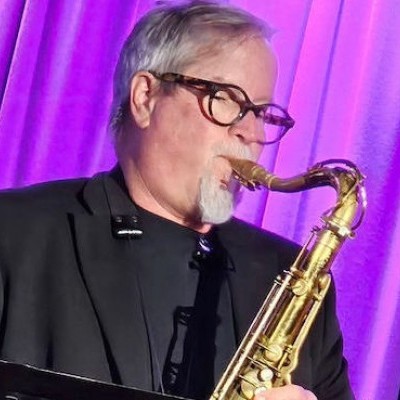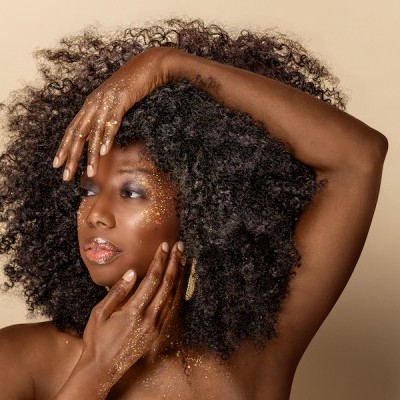Oct 28, 2025 10:47 AM
In Memoriam: Jack DeJohnette, 1942–2025
Jack DeJohnette, a bold and resourceful drummer and NEA Jazz Master who forged a unique vocabulary on the kit over his…

Joachim Kuhn performs at Like a Jazz Machine fest in Dudelange, Luxembourg.
(Photo: Bernd Zimmermann)This sixth edition of Like A Jazz Machine took place over the long Memorial Day weekend (May 25–28), although in Luxembourg the public holiday revolved around Ascension Day. Hardcore jazz is absolutely central to LAJM’s program, with no diversions into outside genres. This is not to say that other musical forms were barred, but if they were invited to play, their roots were deeply buried in a jazz exterior.
Most of the four nights at the National Audiovisual Centre in Dudelange (not far from Luxembourg City, and almost on the French border) featured a quartet of acts, allowing 30 minutes between each set, for contemplation and digestion. This was a novel respite from the frenetic stage-hopping required by most festivals.
The majority of the artists arrived from across Europe, with the exception of the Carla Bley Trio, and even here, their saxophonist Andy Sheppard hails from England. Bley remains active into her early eighties, although she’s now appearing quite frail, but still with a precise touch on the piano keys. Likewise, the 76-year-old Steve Swallow is still nimble as ever. His hollow-bodied five-string acoustic bass guitar boasting a springy resonance.
Bley played a new piece called “Copycat,” part of the tune’s aim being to encourage an immediate chain of mimicry following each new melodic phrase. Calm and contemplative, this was far removed from a cutting contest. It was a playfully sedate and humorously sly slink through soft impersonation. “Up And Down” created a sad-eyed waltzing motion, with Bley and Sheppard going on a chase with each other’s phrases, the latter artist having refined a reined-in toughness in a sophisticated atmosphere. Sheppard’s soprano has a poised perfection, and his tenor was at one point used to produce the most minimal punctuation possible within a piece, a finely controlled single-note emission.
The night of May 27 held one of the strongest lineups. A long-desired collaboration by German pianist Joachim Kühn and Italian trumpeter Enrico Rava finally happened, and was a festival highlight. Kühn opened with Ornette Coleman’s “Beauty And Truth,” bleeding into “The End,” by The Doors, making a free-blues littered with micro-decorations. A slow groove almost turned into reggae, which is not Kühn’s usual slant. Pianistic shards arrived from unexpected angles as he would play a phrase then run off into a cascade. Rivulets of energy flashed between Kühn, bassist Chris Jennings and drummer Gary Husband, but such freedom had to be curtailed once Rava entered, as his presence signaled a switch to his own more controlled repertoire of originals.
Rava concentrated on flugelhorn throughout, improvising with Kühn before easing into “Overboard” and then “Diva”, re-joined by Jennings and Husband. Rava was bristling with energy, speeding up as “Blues For Pablo” arrived, delivered with a forceful density, as if performed by Coltrane rather than Miles. A return to trio formation found Kühn ablaze, inspiring a lashing burst of a drum solo from Husband. Captivating though the foursome with Rava was, Kühn was completely let loose as the leader of his own trio, combining structured runs with flashing instances of free-form mania.
Back on the first evening, the “Hanoi Duo” of guitarist Nguyên Lê and singer/multi-instrumentalist Ngô Hông Quang was expanded into a full ensemble, featuring the Italian trumpeter Paolo Fresu. Also in the ranks were players from Vietnam, Japan and India, providing a variegated spread of flute, percussion, koto and tabla. This was a prime example of successful fusion, with Vietnamese folk music acting as a foundation, surrounded by these other traditional elements, all rocked up by electric guitar. No one needed to compromise, and no ethnic heritage was turned into a mulch.
The opening piece featured a quartet of electric guitar, two-stringed fiddle, small drums and wooden clackers, then the rest of the players emerged for the second number, with Edouard Prabhu’s propulsive tabla work helping to establish an implied groove. Its eventual release was prolonged, with cajon and buzzing jaw-harp building tension, teetering on the edge of explosion. Koto player Mieko Miyazaki started to vocalize, as Lê triggered a taut riff, and Quang emitted a gruff approximation of Tuvan throat singing, almost yodeling at one point. The meshing became incrementally wilder, with an electro-stutter presumably created by Lê’s guitar, often the source of a bendy note paradise.
At first, it looked as though the advertised expansion of Swiss pianist Nik Bärtsch’s Mobile had been abandoned, as this Ronin precursor outfit’s four-piece core were heads-down for an extended bout of genuine minimalism. The leader was joined by two drummers and his sturdy sideman, Sha, playing bass and contrabass clarinets.
Expansive drumkits were in place, but often their owners were content to ripple on chimes or woodblocks, harnessing potent parts of pulse around their array, with maximum restraint, even when caressing a giant gong. Bärtsch resolutely maintained a one-hand-inside-the-piano dampening, while hammering out a dogged repeat. The effect was mesmerizing, and despite the added tonal layers provided by the five string players (when they entered about halfway through the set), we could surely have soaked ourselves in the deeply mysterious quartet atmospherics all night long.
Luxembourg native son Michel Reis was joined by three Japanese players, two of whom he’d studied with, enjoying a lengthy association. Their curious set of new compositions had a mainstream bedrock, with outbreaks of sheer joyous extroversion, boasting a strong escalation of energies between pianist Reis and drummer Shun Ishikawa. Reis suddenly fragmented into freedom, making hammer blows, as Akihiro Nishiguchi’s soprano bleated sharply. The pedestrian was ignited: following periods of calm, the quartet repeatedly ripped up into frenzied stretches of heightened dialogue, as if the members had to rest momentarily between each superhuman exertion.
In this strong festival line-up, there were other contenders too, as The Comet Is Coming charged through a 90-minute set of electroshock therapy, featuring London tenorman Shabaka Hutchings honking through Danalogue The Conqueror’s full-force synthesizer oscillations. The French trumpeter Erik Truffaz offered a more retro 1970s-through-1990s club-funk, his keyboardist Benoît Corboz turning in some crazed solos, often from a kneeling-on-his-swivel-stool position.
Finally, on May 28, Tilt moved the furthest away from jazz, with a twangy, rocky, noir-steeped amalgam of treated flute, angular guitar and electric piano, all underpinned by some fairly leaden but powerful drumming. This Parisian combo could be dubbed Jethro Sabbath. Guitarist Guillaume Magne provided much of the jagged structure, whilst leader Joce Mienniel frequently turned to his primitivist analog synth set-up, or snagged snatches of stuttered flute matter via his foot-pedals. DB

Jack DeJohnette boasted a musical resume that was as long as it was fearsome.
Oct 28, 2025 10:47 AM
Jack DeJohnette, a bold and resourceful drummer and NEA Jazz Master who forged a unique vocabulary on the kit over his…

“I’ve told students, ‘I don’t mind if you use AI for this or that project,’” says MIT’s Pascal Le Boeuf. “‘But you need to tell me.’”
Sep 18, 2025 11:14 AM
A standard joke when it comes to discussing artificial intelligence, or AI, is that it’s developing so rapidly that…

Chuck Manning Works for NASA … and plays jazz.
Sep 18, 2025 11:23 AM
Congratulations! After years of study, you’ve earned your degree in jazz performance. But let’s face it: Making a…

Gadabout Season developed over many months of recording sessions in Brandee Younger’s East Harlem living room.
Sep 16, 2025 11:52 AM
When she’s on the road, Brandee Younger enters a hybrid state of action and contemplation. Free of daily distractions…

Cleo Laine, 1927–2025
Sep 16, 2025 10:03 AM
The music world mourns the loss of three important artists from the realms of jazz, blues and beyond with the recent…